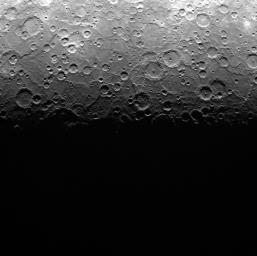
|
WAC’s Changing Footprint
- Click the image above for a larger view
- Full-Res JPEG (1024 x 1020) (128.9 kB)
- Full-Res TIFF (1024 x 1020) (1.0 MB)
Caption:
The surface footprint of MESSENGER's Wide Angle Camera (WAC) changes markedly as the spacecraft moves along its highly elliptical orbit . Here we see an image that includes Mercury's south pole and terminator , viewed from an altitude of ~10,240 km (6363 miles). Approximately half of this image includes portions of Mercury's surface that are not illuminated by the Sun. Compare the extent of this image to those taken from altitudes of ~450 km (280 miles) and ~14,895 km (9255 miles).
Date acquired:
March 31, 2011
Image Mission Elapsed Time (MET):
210035203
Image ID:
71446
Instrument:
Wide Angle Camera (WAC) of the Mercury Dual Imaging System (MDIS)
WAC filter:
7 (748 nanometers)
Center Latitude:
-83.17°
Center Longitude:
250.9° E
Resolution:
1833 meters/pixel
Scale:
The center of this image is about 1970 km (1225 miles) across.
Background Info:
On March 17, 2011 (March 18, 2011, UTC), MESSENGER became the first spacecraft ever to orbit the planet Mercury . The mission is currently in its commissioning phase, during which spacecraft and instrument performance are verified through a series of specially designed checkout activities. In the course of the one-year primary mission, the spacecraft's seven scientific instruments and radio science investigation will unravel the history and evolution of the Solar System's innermost planet. Visit the Why Mercury? section of this website to learn more about the science questions that the MESSENGER mission has set out to answer.
These images are from MESSENGER, a NASA Discovery mission to conduct the first orbital study of the innermost planet, Mercury. For information regarding the use of images, see the MESSENGER image use policy .
Cataloging Keywords:
| Name | Value | Additional Values |
|---|---|---|
| Target | Mercury | |
| System | ||
| Target Type | Planet | |
| Mission | MESSENGER | |
| Instrument Host | MESSENGER | |
| Host Type | Orbiter | |
| Instrument | Mercury Dual Imaging System (MDIS) | |
| Detector | Wide Angle Camera (WAC) | |
| Extra Keywords | Grayscale, Radio | |
| Acquisition Date | ||
| Release Date | 2011-04-01 | |
| Date in Caption | 2011-03-31 | |
| Image Credit | NASA/Johns Hopkins University Applied Physics Laboratory/Carnegie Institution of Washington | |
| Source | photojournal.jpl.nasa.gov/catalog/PIA14195 | |
| Identifier | PIA14195 | |
